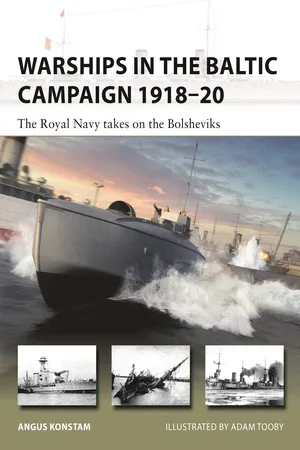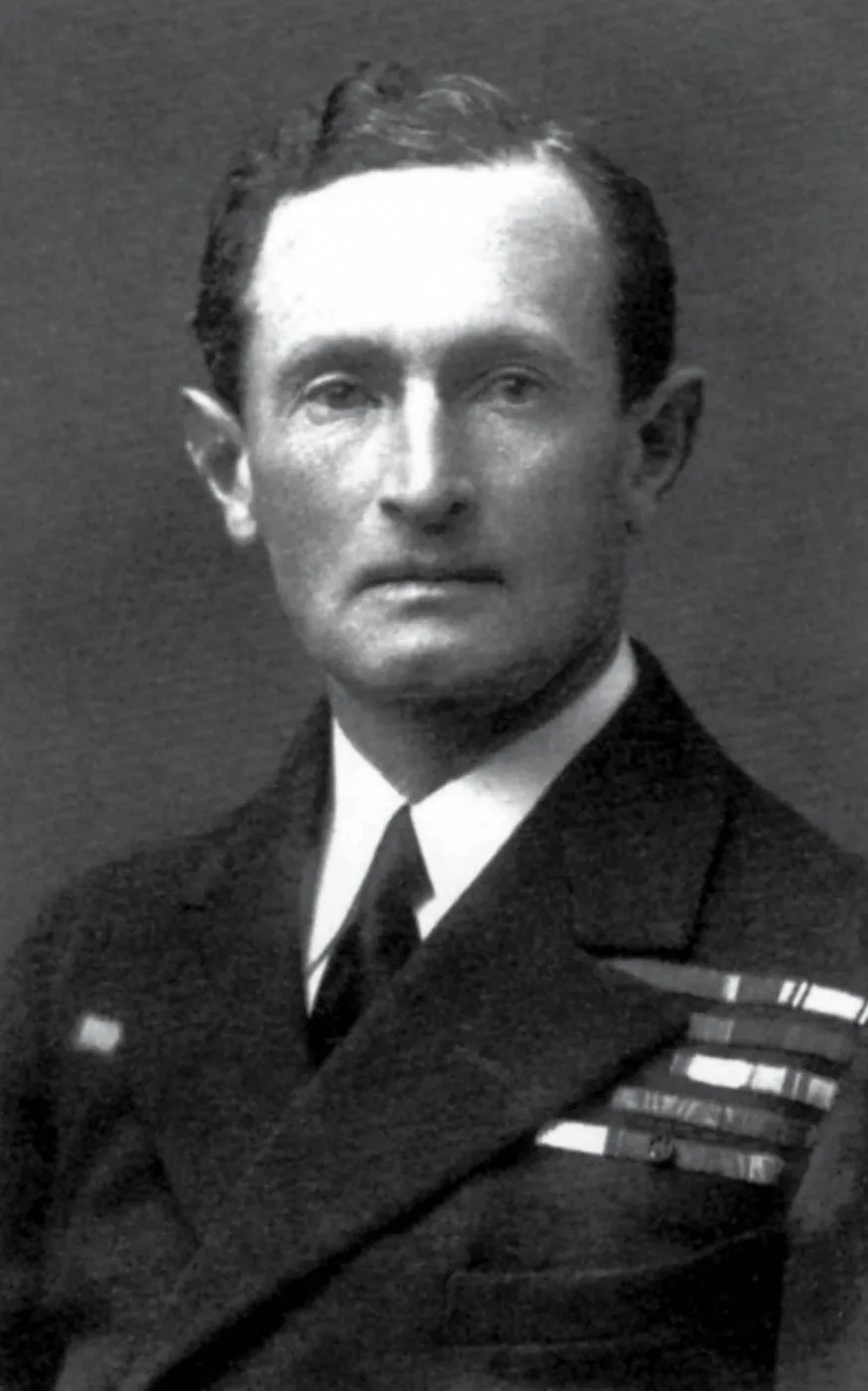
eBook - ePub
Warships in the Baltic Campaign 1918–20
The Royal Navy takes on the Bolsheviks
- 48 pages
- English
- ePUB (mobile friendly)
- Available on iOS & Android
eBook - ePub
Warships in the Baltic Campaign 1918–20
The Royal Navy takes on the Bolsheviks
About this book
A fascinating look at the British naval intervention in the Baltic in 1918–20, and at the British, Soviet and Baltic nationalist fleets that fought.
Following the Russian Revolution of October 1917, the Baltic states became a battleground between Russian Reds and Whites, German troops and emerging Baltic independence forces. In November 1918, the British government decided to intervene, to protect British interests and to support the emerging Baltic states.
This initial small force of cruisers and destroyers was eventually augmented by other British warships, including aircraft carriers, a monitor, as well as a handful of submarines and torpedo boats. Opposing them was the far more powerful Russian Baltic Fleet, now controlled by the Bolsheviks. The campaign that followed involved naval clashes between the two sides, the most spectacular of which was an attack on the Soviet naval base of Kronstadt in June 1919 by a force of small British torpedo boats. They torpedoed and sunk the Russian cruiser Oleg, an action which effectively bottled the Baltic fleet up in port for the remainder of the campaign. Finally, in early 1920, the British squadron was withdrawn, following Soviet recognition of Estonia, Latvia and Lithuania.
This New Vanguard title explores the naval side of this little-known but strategically crucial campaign fought by the war-weary navies of Britain and Russia and by warships of the emerging Baltic states. Describing the political background to the conflict, and the key points of the naval campaign as well as the warships involved, this is a concise and fascinating account of an overlooked naval campaign that helped reshape the map of Europe.
Following the Russian Revolution of October 1917, the Baltic states became a battleground between Russian Reds and Whites, German troops and emerging Baltic independence forces. In November 1918, the British government decided to intervene, to protect British interests and to support the emerging Baltic states.
This initial small force of cruisers and destroyers was eventually augmented by other British warships, including aircraft carriers, a monitor, as well as a handful of submarines and torpedo boats. Opposing them was the far more powerful Russian Baltic Fleet, now controlled by the Bolsheviks. The campaign that followed involved naval clashes between the two sides, the most spectacular of which was an attack on the Soviet naval base of Kronstadt in June 1919 by a force of small British torpedo boats. They torpedoed and sunk the Russian cruiser Oleg, an action which effectively bottled the Baltic fleet up in port for the remainder of the campaign. Finally, in early 1920, the British squadron was withdrawn, following Soviet recognition of Estonia, Latvia and Lithuania.
This New Vanguard title explores the naval side of this little-known but strategically crucial campaign fought by the war-weary navies of Britain and Russia and by warships of the emerging Baltic states. Describing the political background to the conflict, and the key points of the naval campaign as well as the warships involved, this is a concise and fascinating account of an overlooked naval campaign that helped reshape the map of Europe.
Frequently asked questions
Yes, you can cancel anytime from the Subscription tab in your account settings on the Perlego website. Your subscription will stay active until the end of your current billing period. Learn how to cancel your subscription.
At the moment all of our mobile-responsive ePub books are available to download via the app. Most of our PDFs are also available to download and we're working on making the final remaining ones downloadable now. Learn more here.
Perlego offers two plans: Essential and Complete
- Essential is ideal for learners and professionals who enjoy exploring a wide range of subjects. Access the Essential Library with 800,000+ trusted titles and best-sellers across business, personal growth, and the humanities. Includes unlimited reading time and Standard Read Aloud voice.
- Complete: Perfect for advanced learners and researchers needing full, unrestricted access. Unlock 1.4M+ books across hundreds of subjects, including academic and specialized titles. The Complete Plan also includes advanced features like Premium Read Aloud and Research Assistant.
We are an online textbook subscription service, where you can get access to an entire online library for less than the price of a single book per month. With over 1 million books across 1000+ topics, we’ve got you covered! Learn more here.
Look out for the read-aloud symbol on your next book to see if you can listen to it. The read-aloud tool reads text aloud for you, highlighting the text as it is being read. You can pause it, speed it up and slow it down. Learn more here.
Yes! You can use the Perlego app on both iOS or Android devices to read anytime, anywhere — even offline. Perfect for commutes or when you’re on the go.
Please note we cannot support devices running on iOS 13 and Android 7 or earlier. Learn more about using the app.
Please note we cannot support devices running on iOS 13 and Android 7 or earlier. Learn more about using the app.
Yes, you can access Warships in the Baltic Campaign 1918–20 by Angus Konstam,Adam Tooby in PDF and/or ePUB format, as well as other popular books in History & Baltic History. We have over one million books available in our catalogue for you to explore.
Information
THE ALLIED FLEET
On 22 November 1918, Alexander-Sinclair received orders to take his 6th Light Cruiser Squadron to the Baltic. At the time, it consisted of his flagship Cardiff and four other Caledon- and Ceres-class light cruisers (Cassandra, Caradoc, Ceres and Calypso). These were the most modern cruisers in the Grand Fleet, all armed with five 6in guns. They would form the core of the British force, but Alexander-Sinclair’s command would also include nine modern V&W-class destroyers of the 13th Destroyer Flotilla (Valkyrie, Vendetta, Verulam, Wakeful, Wessex, Westminster, Windsor, Wolfhound and Woolston). As the Baltic was known to be sown with numerous German and Russian mines, the force would also include seven Hunt-class minesweepers, drawn from the 3rd and 8th Minesweeping Flotillas (Cottesmore, Epsom, Eridge, Hambledon, Hurst, Sandown and Tedworth).

R. Adml Cowan’s small fleet of light cruisers and destroyers, seen off Björkö in July 1919 from one of the aircraft brought out on board the aircraft carrier Vindictive. Cowan’s forward base at Björkö lay close to the northern end of the Soviet protective minefields, and so his ships were well placed to react to any Soviet sortie.
Also included in Alexander-Sinclair’s force were the auxiliary minelayers Angora and Princess Margaret, which on this trip would be carrying weapons and ammunition in place of their usual cargo. These were earmarked for Estonian and Latvian troops, to be distributed at the Rear-admiral’s discretion after his arrival in Baltic waters. On 1 December, when the British ships reached Copenhagen, Alexander-Sinclair learned that the collier Tregarth, which was to meet him there, had run aground. While fuel-oil was readily available in Copenhagen, coal was not. So, the Admiral had no choice but to leave his coal-burning minesweepers behind, with orders to follow on once their bunkers were replenished.
Cassandra was lost to a mine off the Latvian coast on 5 December and Calypso, Westminster and Verulam were all damaged in various ways and sent home for repairs. Otherwise, these British warships remained in the Baltic until the end of the year. On 24 December four more V&W-class destroyers of the 14th Flotilla arrived in the Baltic (Vendetta, Woolston and Wrestler, led by Capt Arthur Wood in Vampire). When Alexander-Sinclair’s force returned home in early January 1919, all these ships returned with him, save the Angora, which had already sailed. When he reached Copenhagen on 5 January, Alexander-Sinclair was able to brief his replacement, R. Adml Walter Cowan, who was on his way out to the Baltic. Cowan had his flagship Caledon, the namesake of her class, as well as the Arethusa-class Royalist. From January, these two light cruisers would become the core of Cowan’s small force.
At the time, the light cruisers Concord and Curlew were in Danzig (now Gdansk), and in early February they were recalled and replaced by Phaeton and Inconstant, both of the Arethusa class, accompanied by five V&W-class destroyers of the 2nd Flotilla (Vidette, Vimiera, Westcott, Westminster and Wolfhound). On 19 February, when Cowan left to consult the Admiralty, he took Caledon, Royalist and the destroyers with him, leaving Capt John Cameron of Phaeton in command in the Baltic. When Cowan returned two weeks later, Royalist remained in Britain and was replaced by Cleopatra, of the Caroline class. Cowan was also given five older S-class destroyers of the 7th Flotilla (Seafire, Searcher, Sepoy, Scotsman and Scout), and the Angora, laden with more arms and ammunition.3
E
SOVIET WARSHIPS: DESTROYER AVTROIL, SUBMARINE PANTERA

1. Destroyer Avtroil
The Avtroil, a vessel of the Izyaslav class, was one of the largest and best-armed destroyers in the Soviet Baltic Fleet. This three-ship class was based on the successful pre-war Novik-class design. Avtroil was laid down in the Putilov yard in Petrograd in December 1914, and commissioned into the Baltic Fleet two years later. She carried five 102mm (4in) guns and nine 450mm (18in) torpedo tubes in three triple launchers, as well as a single 63mm anti-aircraft gun. This meant that in 1919 she was better-armed than most of her British counterparts. However, this didn’t prevent her capture in December 1918. She was then handed over to the Estonians, who renamed her Lennuk, and added her to their small fleet. This shows her as she looked at the time of her capture.
2. Submarine Pantera
The 24 Bars-class submarines were the most advanced in the Imperial Russian Navy during World War I, but they compared poorly with German or Western Allied boats. Their engines weren’t particularly good, they lacked watertight bulkheads and they were slow to dive. Pantera (Panther) joined the Baltic Fleet in mid-1916, and by late 1918 was one of seven Bars-class boats that were still operational. Although she never achieved much during the war, she made up for it on 31 August 1919 when she sank the British destroyer Vittoria. This was the most spectacular Soviet success of the campaign.

R. Adml Walter Cowan, a veteran of Jutland (1916) and Heligoland Bight (1917), was given the Baltic command in January 1919. He pursued an aggressive policy, containing the Soviet Baltic Fleet in the Gulf of Finland while exerting complete control over the rest of the Baltic Sea. He was knighted...
Table of contents
- Cover
- Title Page
- Table of Contents
- Introduction
- Background
- The Campaign
- The Soviet Baltic Fleet
- The Allied Fleet
- Further Reading
- eCopyright